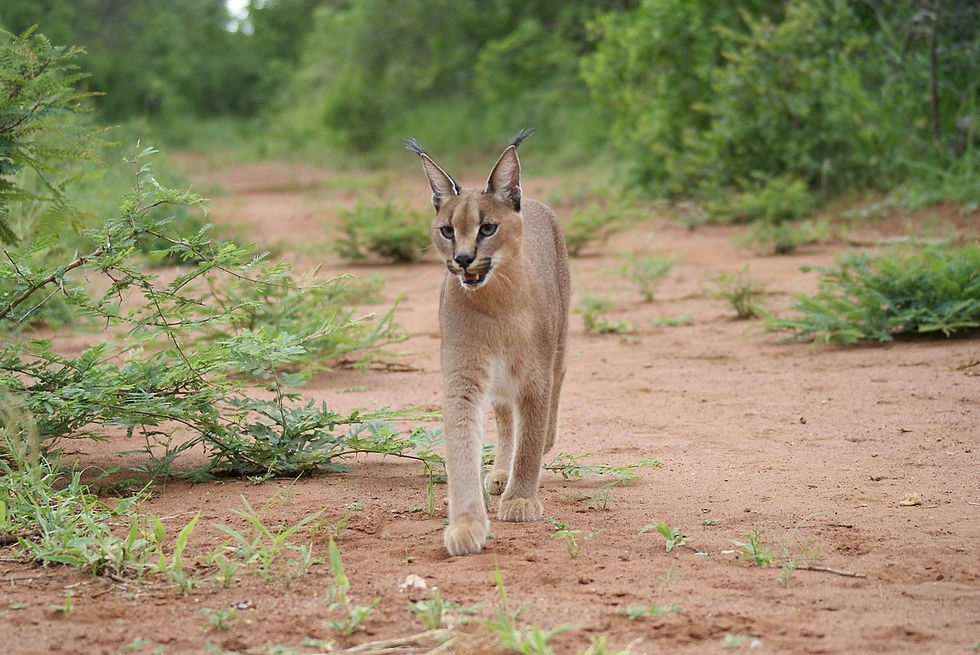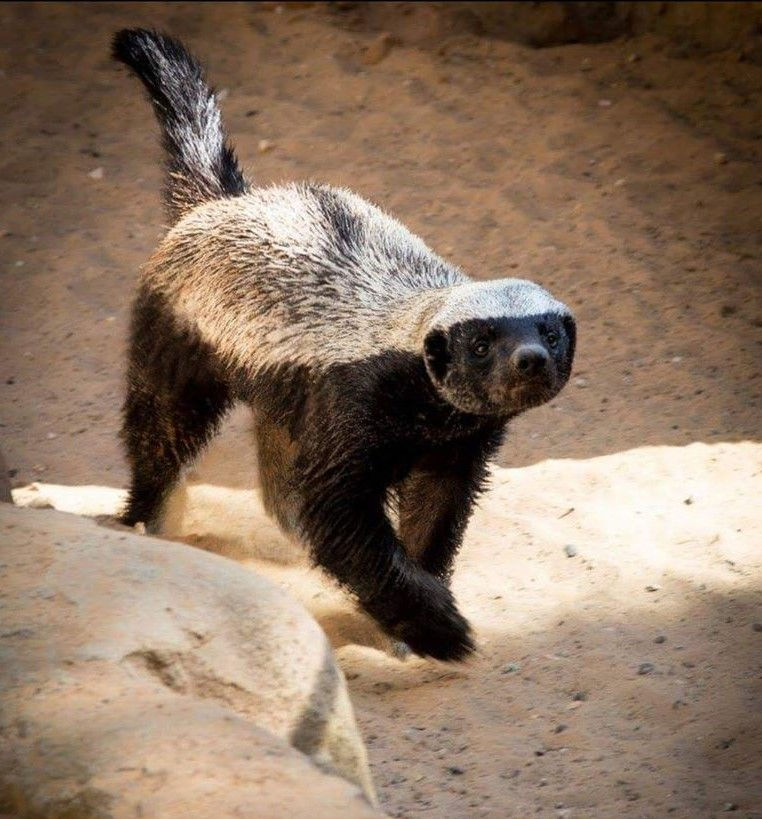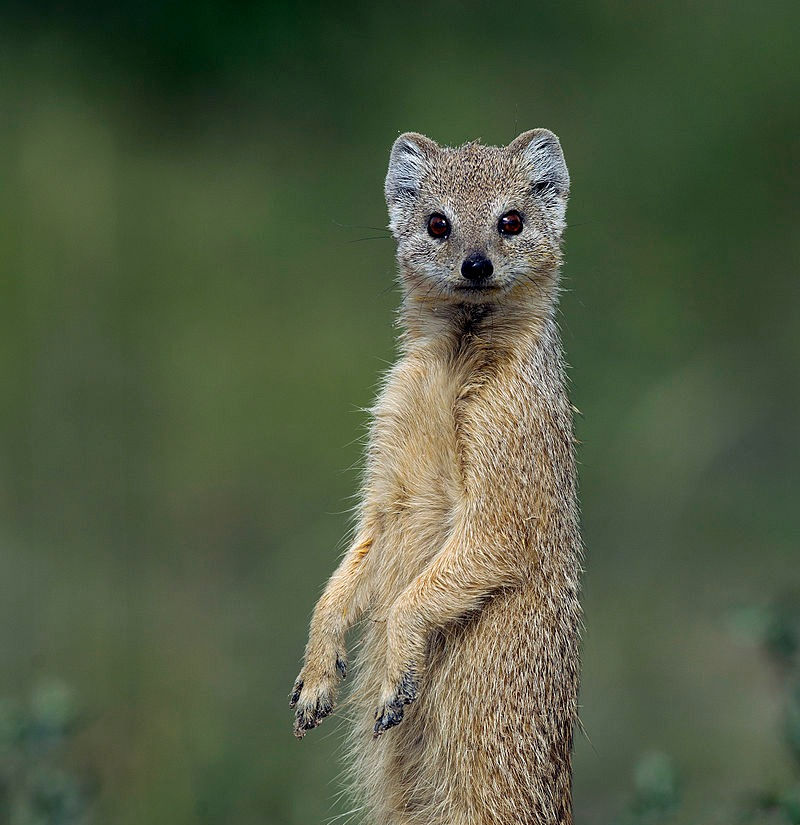SMALL PREDATORS OF
SOUTHERN
AFRICA
There are many small and usually far more illusive predators than the larger more common predators of Africa. Images, links and information to the following animal cards are provided for by www.wikipedia.org and through our own images and descriptions.
BLACK-BACKED JACKAL
@Eastern/Southern Africa




#Lupulella mesomelas , A medium sized canine native to eastern and southern Africa. It is listed by the IUCN as least concern, due to its widespread range and adaptability, although it is still persecuted as a livestock predator and rabies vector.
CAPE FOX
@Southern Africa




#Vulpes chama , The Cape fox, also called the asse, cama fox or the silver-backed fox, is a small species of fox, native to southern Africa. It is also called a South African version of a fennec fox due to its similarly big ears. It is the only "true fox" occurring in sub-Saharan Africa, and it retains primitive characteristics of Vulpes because it diverged early in the evolutionary history of the group.
CARACAL
@Africa/Middle East/Central Asia




#Caracal caracal , The caracal is a medium-sized wild cat native to Africa, the Middle East, Central Asia, and arid areas of Pakistan and northwestern India. It is characterised by a robust build, long legs, a short face, long tufted ears, and long canine teeth. Its coat is uniformly reddish tan or sandy, while the ventral parts are lighter with small reddish markings.
AFRICAN WILDCAT
@ Africa/West/Central Asia


#Felis lybica , A small wildcat species native to Africa, West and Central Asia up to Rajasthan in India and Xinjiang in China.
The IUCN Red List status Least Concern is attributed to the species Felis silvestris, which at the time of assessment also included the African wildcat as a subspecies
HONEY BADGER
@Africa/Southwest Asia/India




#Mellivora capensis , also known as the ratel a mammal widely distributed in Africa, Southwest Asia, and the Indian subcontinent. Because of its wide range and occurrence in a variety of habitats, it is listed as Least Concern on the IUCN Red List.
AFRICAN CIVET
@Africa




#Civettictis civetta , A large viverrid native to sub-Saharan Africa, where it is considered common and widely distributed in woodlands and secondary forests. It is listed as Least Concern on the IUCN Red List since 2008. In some countries, it is threatened by hunting, and wild-caught individuals are kept for producing civetone for the perfume industry.
AFRICAN CLAWLESS OTTER
@Africa




#Aonyx capensis , Also known as the Cape clawless otter or groot otter, is the second-largest freshwater otter species. It inhabits permanent water bodies in savannah and lowland forest areas through most of sub-Saharan Africa. It is characterized by partly webbed and clawless feet, from which their name is derived.
COMMON GENET
@Africa/Asia/Europe


#Genetta genetta , a small viverrid indigenous to Africa that was introduced to southwestern Europe and the Balearic Islands. It is widely distributed north of the Sahara, in savanna zones south of the Sahara to southern Africa and along the coast of Arabia, Yemen and Oman. It is listed as Least Concern on the IUCN Red List.
YELLOW MONGOOSE
@Southern Africa




#Cynictis penicillata , sometimes referred to as the red meerkat, is a member of the mongoose family. It lives in open country, semi-desert scrubland and grasslands in Angola, Botswana, South Africa, Namibia, and Zimbabwe.
CAPE GRAY MONGOOSE
@South Africa/Namibia/Lesotho


#Herpestes pulverulentus , Also called the small grey mongoose, is a small mammal with a dark grey colour with a darker tip of the tail. The legs are a darker grey than the rest of the body. It has a typical elongated mongoose body-shape. The ears are small and rounded and are situated on the sides of the head. The tail is long and bushy. The teeth show adaptations for both cutting and crushing.
MARSH MONGOOSE
@Sub-Saharan Africa



#Atilax paludinosus , Also known as the water mongoose,it is a medium-sized mongoose native to sub-Saharan Africa that inhabits foremost freshwater wetlands. It has been listed as Least Concern on the IUCN Red List since 2008.
NARROW-STRIPED MONGOOSE
@Madagascar


#Mungotictis decemlineata , A member of the family Eupleridae endemic to Madagascar. It inhabits the Madagascar dry deciduous forests in western and southwestern Madagascar, where it lives from sea level to about 125 m (410 ft) between the Tsiribihina and Mangoky rivers. In Malagasy it is called bokiboky (pronounced "Boo-ky Boo-ky").
MALAGASSY CIVET
@Madagascar


#Fossa fossana , The Malagasy or striped civet, also known as the fanaloka or jabady, is an euplerid endemic to Madagascar. The Malagasy civet is nocturnal, though sources disagree over whether it is solitary or, unusual among euplerids, lives in pairs. It is not a good climber and frequents ravines. It eats small vertebrates (mammals, reptiles, and amphibians), insects, aquatic animals, and eggs stolen from birds' nests.
WHITE-TAILED MONGOOSE
@Africa/Arabian Peninsula


#Ichneumia albicauda , It appears to be the longest and heaviest extant species of mongoose, although its linear and body mass parameters broadly overlap with other larger mongoose species, in particular, the marsh mongoose seems to most closely rival (and possibly match) in range of body masses reported if not average weight
SIDE-STRIPED JACKAL
@Central/Southern Africa




#Lupulella adusta , A canine native to central and southern Africa. Unlike the smaller and related black-backed jackal (Lupulella mesomelas), which dwells in open plains, the side-striped jackal primarily dwells in woodland and scrub areas.
BAT-EARED FOX
@Eastern/Southern Africa


#Otocyon megalotis , A species of fox found on the African savanna. It is the only extant species of the genus Otocyon and considered a basal canid species. Fossil records indicate this canid first appeared during the middle Pleistocene.
SERVAL
@Africa




#Leptailurus serval , A wild cat native to Africa. It is rare in North Africa and the Sahel, but widespread in sub-Saharan countries, except rainforest regions. Across its range, it occurs in protected areas, and hunting it is either prohibited or regulated in range countries.
BLACK-FOOTED CAT
@Southern Africa




#Felis nigripes , also called the small-spotted cat, is the smallest wild cat in Africa, having a head-and-body length of 35–52 cm (14–20 in). Despite its name, only the soles of its feet are black or dark brown. With its bold small spots and stripes on the tawny fur, it is well camouflaged, especially on moonlit nights.
STRIPED POLECAT
@Africa



#Ictonyx striatus , Also called the African polecat, zoril, zorille, zorilla, Cape polecat, and African skunk - is a member of the family Mustelidae that resembles a skunk. It lives predominantly in dry and arid climates, such as the savannahs and open country of Central, Southern, and sub-Saharan Africa, excluding the Congo basin and the more coastal areas of West Africa.
FOSSA
@Madagascar



#Cryptoprocta ferox , A carnivorous mammal that is endemic to Madagascar. It is a member of the Eupleridae, a family of carnivorans closely related to the mongoose family Herpestida. The fossa is the largest mammalian carnivore on Madagascar and has been compared to a small cougar, as it has convergently evolved many cat-like features.
CAPE GENET
@South Africa



#Genetta tigrina , Also known as the South African large-spotted genet, is a genet species endemic to South Africa. As it is common and not threatened, it is listed as Least Concern on the IUCN Red List. Like other genets, it is nocturnal and arboreal, preferring to live in the riparian zones of forests, as long as these are not marshy areas.
MEERKAT
@Southern Africa




#Suricata suricatta , Also known as a suricate is a small mongoose found in southern Africa. It is characterised by a broad head, large eyes, a pointed snout, long legs, a thin tapering tail, and a brindled coat pattern. The coat is light grey to yellowish brown with alternate, poorly defined light and dark bands on the back.
COMMON SLENDER MONGOOSE
@Sub-Saharan Africa


#Herpestes sanguineus , also known as the black-tipped mongoose or the black-tailed mongoose, is a very common mongoose species native to sub-Saharan Africa. The common slender mongoose generally lives either alone or in pairs. It is primarily diurnal, although it is sometimes active on warm, moonlit nights.
GRANDIDIER'S MONGOOSE
@Madagascar


#Galidictis grandidieri , also known as the giant-striped mongoose or Grandidier's vontsira, is a small carnivoran that lives only in a very small area of southwestern Madagascar, in areas of spiny forest vegetation. It is pale brown or grayish coloured, with eight wide, dark stripes on its back and sides.
BANDED MONGOOSE
@Africa



#Mungos mungo , A mongoose species native from the Sahel to Southern Africa. It lives in savannas, open forests and grasslands and feeds primarily on beetles and millipedes. Mongooses use various types of dens for shelter including termite mounds. While most mongoose species live solitary lives, the banded mongoose live in colonies with a complex social structure.
COMMON DWARF MONGOOSE
@Southern/East Africa



#Helogale parvula , A mongoose species native to Angola, northern Namibia, KwaZulu-Natal in South Africa, Zambia and East Africa. It is part of the genus Helogale and as such related to Helogale hirtula. It has a large pointed head, small ears, a long tail, short limbs and long claws. The species can be distinguished from other mongooses by its size.
RING TAILED VONTSIRA
@Madagascar



#Galidia elegans , The ring-tailed vontsira, locally still known as the ring-tailed mongoose is a euplerid in the subfamily Galidiinae, a carnivoran native to Madagascar. The ring-tailed vontsira is relatively small but is the largest member of the subfamily Galidiinae.









.png)
.png)